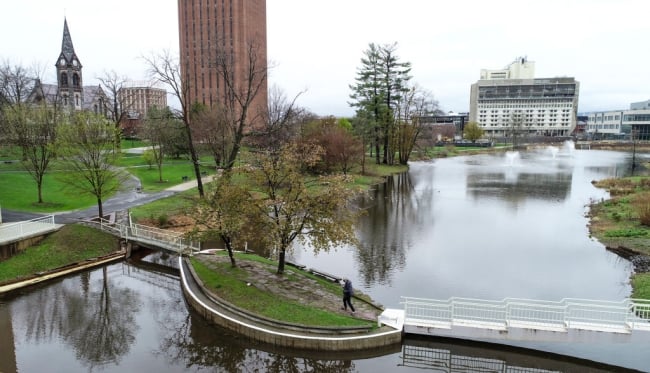You have /5 articles left.
Sign up for a free account or log in.

The University of Massachusetts at Amherst is one of many universities putting cost-cutting measures into place this fall.
Boston Globe/Contributor via Getty Images
The beginning of September marked the start of long-term furloughs for many colleges. After widespread budget slashing and subsequent furloughs in April, a second wave of revenue shortfalls is sweeping colleges as they attempt to safely reopen for in-person classes and, in some cases, abruptly reverse course.
Winthrop University’s Board of Trustees last week approved a furlough plan that will impact hundreds of employees. Between Sept. 1 and June 30 of next year, more than 700 Winthrop employees will be required to take between two and 20 furlough days, depending on their position, according to Winthrop spokesperson Monica Bennett.
The public university in South Carolina delayed the start of in-person instruction until Sept. 8, which cost it $1.4 million in revenue, interim President George Hynd wrote in an Aug. 24 message to faculty and staff members. In all, the university is facing a $6.3 million budget shortfall.
“Comparing last year’s operating budget to this year’s budget, we have already cut 10 percent. We are continuing our hiring freeze with a few exceptions,” Hynd wrote. “We also are dealing with several continuing unknowns. Our auxiliary revenues will be down as a result of more students choosing online learning and not living on campus.”
In-person instruction delays and last-minute changes to reopening plans have put a financial strain on many colleges, including Winthrop.
“If the need to pivot back to remote learning becomes a reality, then there will likely be additional budget implications,” said Bennett.
Typically, about 60 percent of college spending goes toward salaries and personnel, according to Ken Rodgers, director at S&P Global. This makes it difficult to slim down budgets without cutting into employee paychecks, even after implementing hiring freezes, eliminating travel spending and halting retirement contributions. Many colleges took those one-time actions last spring to stave off personnel cuts and are left with few cost-cutting options this fall.
The University of Massachusetts at Amherst in early August rolled back plans to bring all students back to campus. Several weeks later, UMass Amherst chancellor Kumble Subbaswamy announced a plan to indefinitely furlough 850 employees, primarily dining hall workers and residence hall operations staff.
In total, the university faces a $168.8 million revenue shortfall, which includes a $67.4 million loss of housing and dining revenue and a projected $30.6 million decline in tuition revenue. Subbaswamy expects layoffs will follow the furlough plan.
Clemson University also implemented a furlough plan that began Sept. 1. It will require more than 3,000 employees to take a number of furlough days depending on their salaries. James Clements, president of Clemson, and all athletics employees making more than $400,000 will also take a voluntary 10 percent salary reduction. The university projects to lose between $120 million and $180 million due to the pandemic, according to a Clemson spokesperson.
Tufts University has laid off 76 employees in its dental program and furloughed another 26 people for four months. George Washington University is planning to furlough and lay off some employees and implement pay cuts. The University of Portland has implemented furloughs and pay cuts for some employees.
Athletics programs, a moneymaker for many big universities, are also facing significant revenue losses this fall. Many athletic conferences, including the Big Ten and Pac-12, have postponed or canceled the fall season.
At the University of Nebraska, the Huskers’ football season has been postponed. The team typically pulls in millions for the university each season. Without fall sports, the athletics department predicts a revenue shortfall of up to $100 million.
As a result, the university will furlough 51 athletic department employees between Sept. 1 and Dec. 31. All other athletics employees will take a 10 percent salary reduction.
“The postponement of the fall sports season, and specifically the football season, has put us in the position of making some very difficult decisions that impact every member of our staff,” athletics director Bill Moos said in a press release. “In my three decades as an athletic director, I have always said that people are our most valuable resource and there is no question that is true here at Nebraska. These are outstanding staff members and great people, and that is what makes this a particularly tough day.”
Earlier this summer, the department announced several cost-cutting measures including a 10 percent staff reduction, a freeze on merit pay increases and reductions to departmental budgets.
Indiana University, another Big Ten member, announced Friday that all athletics staff members would be required to take a two-week, unpaid furlough between Oct. 1 and June 30. Some staff members will be reduced to working every other week, and still others will be furloughed indefinitely. The University of North Carolina at Greensboro announced in August that all full-time athletics staff would be furloughed for 20 days between Sept. 1 and Dec. 31. The University of Texas at Austin announced Tuesday that it will lay off 35 athletics employees, furlough an additional 35 and have more than 200 athletics employees take pay cuts.




